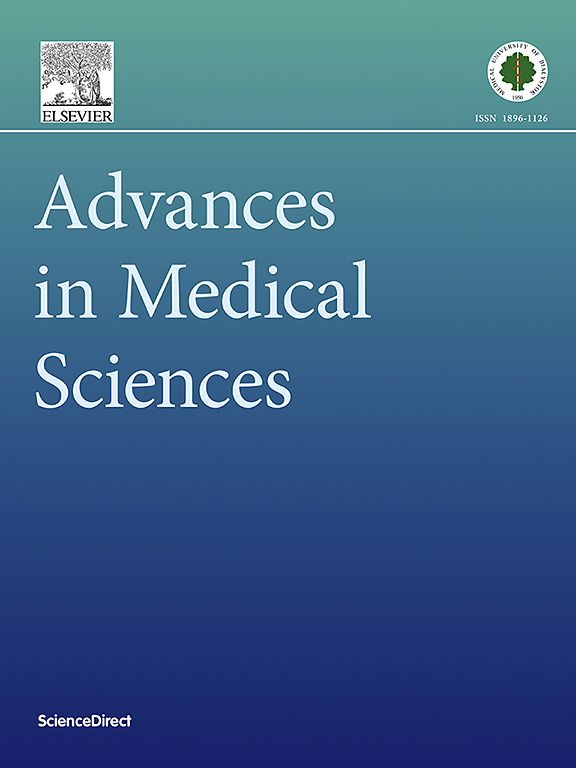QT variability and myocardial repolarization in sleep apnea: implications for cardiac risk
IF 2.6
4区 医学
Q3 MEDICINE, RESEARCH & EXPERIMENTAL
引用次数: 0
Abstract
Purpose
Due to the increased risk of sudden cardiac death, we decided to assess ECG parameters related to the stability of the myocardial repolarization period, i.e. the corrected QT interval (QTc) and derivatives describing its variability (QTV and QTVi).
Methods
Healthy volunteers (n = 187) with visceral obesity, aged 35–65 years, were included. Each participant underwent Holter-ECG and polygraphy simultaneously. According to the severity of breathing disorders during sleep the cohort was divided into 3 groups: Respiratory Event Index (REI) 5–14/hour, REI 15–30/hour, REI ≥ 30/hour. The values of QT parameters were compared between obstructive sleep apnea (OSA)-positive and -negative group as well as among OSA positive group (depending on the OSA severity degree).
Results
We enrolled 121 patients, mean age 47.57 ± 9.36 (47 % female), mean BMI 32.18 ± 5.98 kg/m2, 70 (58 %) of them were diagnosed with OSA, mean REI 26.79 ± 25.66/hour. In OSA group, QTV and QTVi were higher (p < 0.001) however QTc max was not significantly longer (p = 0.06).
Furthermore, we found significantly increased QTc max and QTVi in OSA positive patients during respiratory events compared to normal breathing (p = 0.02 and p = 0.008, respectively). Additionally, we found a positive correlation between REI and QTc max (p = 0.004, R = 0.22). Parameters related to hypoxia (oxygen desaturation index 4 %, time with SpO2 <90 %, SpO2 min, SpO2 mean) also presented a positive correlation with QTc max. Variables were not dependent on age or BMI.
Conclusions
Repolarization of cardiomyocytes is impaired in patients with OSA. The severity of impairment is positively correlated with the severity of sleep-related breathing disorders and hypoxemia.
睡眠呼吸暂停的QT变异性和心肌复极:对心脏风险的影响。
目的:由于心源性猝死的风险增加,我们决定评估与心肌复极期稳定性相关的心电图参数,即校正QT间期(QTc)和描述其变异性的衍生物(QTV和QTVi)。方法:纳入年龄在35 ~ 65岁之间的内脏型肥胖健康志愿者187例。每位参与者同时进行动态心电图和测谎。根据睡眠中呼吸障碍的严重程度将队列分为3组:呼吸事件指数(REI) 5 ~ 14/h、REI 15 ~ 30/h、REI≥30/h。比较阻塞性睡眠呼吸暂停(OSA)阳性组和阴性组以及OSA阳性组(视OSA严重程度而定)QT间期参数值。结果:121例患者入组,平均年龄47.57±9.36(女性占47%),平均BMI 32.18±5.98 kg/m2,其中70例(58%)确诊为OSA,平均REI 26.79±25.66/h。结论:OSA患者心肌细胞复极功能受损。损害的严重程度与睡眠相关呼吸障碍和低氧血症的严重程度呈正相关。
本文章由计算机程序翻译,如有差异,请以英文原文为准。
求助全文
约1分钟内获得全文
求助全文
来源期刊

Advances in medical sciences
医学-医学:研究与实验
CiteScore
5.00
自引率
0.00%
发文量
53
审稿时长
25 days
期刊介绍:
Advances in Medical Sciences is an international, peer-reviewed journal that welcomes original research articles and reviews on current advances in life sciences, preclinical and clinical medicine, and related disciplines.
The Journal’s primary aim is to make every effort to contribute to progress in medical sciences. The strive is to bridge laboratory and clinical settings with cutting edge research findings and new developments.
Advances in Medical Sciences publishes articles which bring novel insights into diagnostic and molecular imaging, offering essential prior knowledge for diagnosis and treatment indispensable in all areas of medical sciences. It also publishes articles on pathological sciences giving foundation knowledge on the overall study of human diseases. Through its publications Advances in Medical Sciences also stresses the importance of pharmaceutical sciences as a rapidly and ever expanding area of research on drug design, development, action and evaluation contributing significantly to a variety of scientific disciplines.
The journal welcomes submissions from the following disciplines:
General and internal medicine,
Cancer research,
Genetics,
Endocrinology,
Gastroenterology,
Cardiology and Cardiovascular Medicine,
Immunology and Allergy,
Pathology and Forensic Medicine,
Cell and molecular Biology,
Haematology,
Biochemistry,
Clinical and Experimental Pathology.
 求助内容:
求助内容: 应助结果提醒方式:
应助结果提醒方式:


